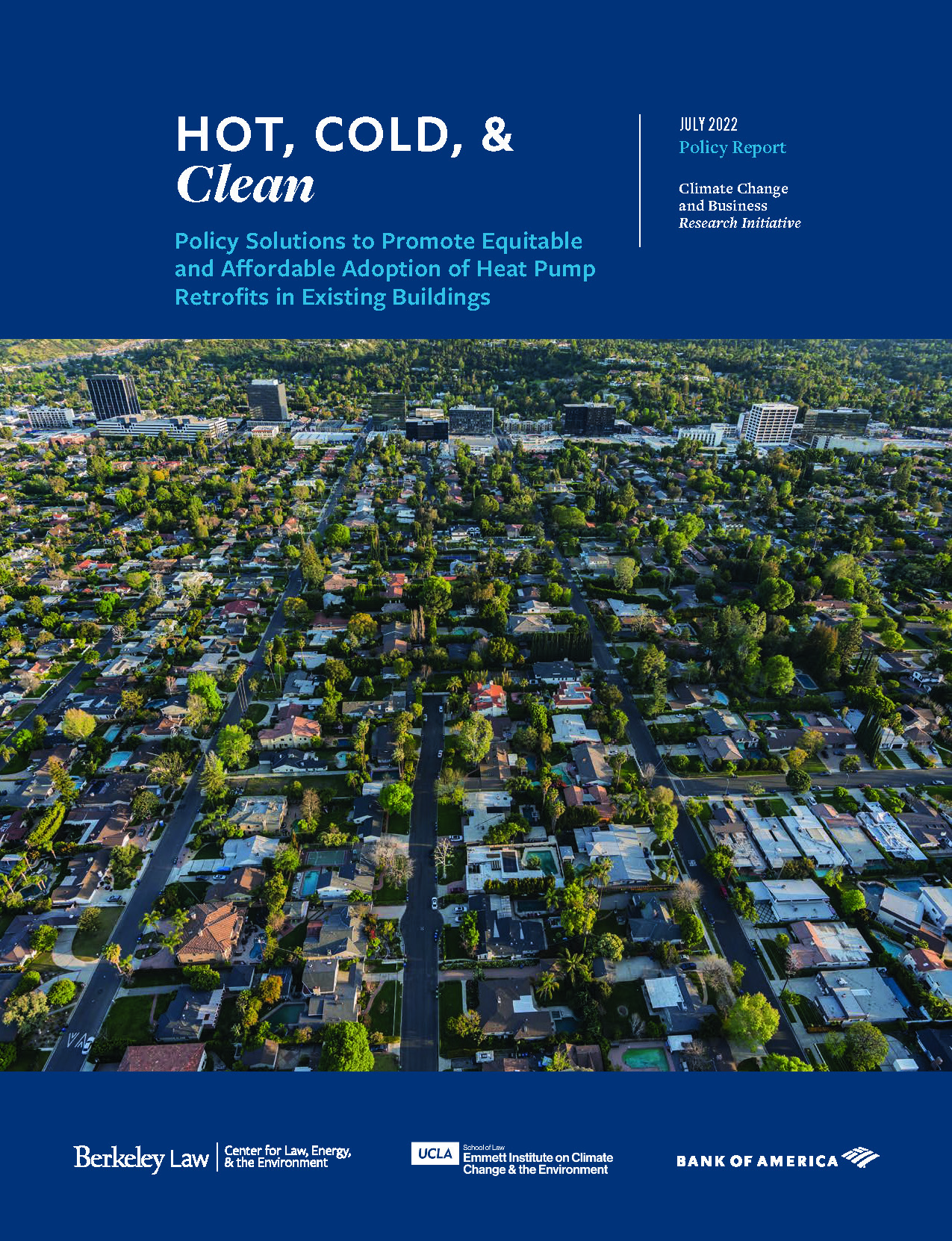
This post is co-authored by Ross Zelen.
As California and other leading climate jurisdictions move toward all-electric buildings, replacing older gas-powered furnaces and air conditioning units with heat pumps can reduce carbon emissions and indoor air pollution while increasing efficiency, comfort and resiliency, especially as extreme heat events increase. Heat pumps are a highly efficient technology that provides all-electric space and water heating and cooling, acting essentially as a two-way air conditioner.
Today, the Center for Law, Energy and the Environment (CLEE) at Berkeley Law and the Emmett Institute on Climate Change and the Environment at UCLA Law are releasing a new report, Hot, Cold, & Clean: Policy Solutions to Promote Equitable and Affordable Adoption of Heat Pump Retrofits in Existing Buildings, which highlights key policy solutions to ensure that California’s push to decarbonize existing homes and buildings will support equitable deployment of electric heat pumps.
Top-priority strategies include setting a clear phaseout timeline for natural gas space and water heaters, protecting low-income tenants from inadvertent rent increases or increased utility costs, and supporting “high road” job training programs to turn heating, ventilation and air conditioning (HVAC) installers and contractors into heat pump champions.
The stakes are high: California’s residential and commercial building sector accounts for nearly a quarter of the state’s greenhouse gas emissions and combustion of fuel for heating and cooling buildings generates more than 10 percent of state emissions. Electric heat pumps provide a deployable solution to reduce emissions from furnaces, water heaters, and other building appliances. To achieve state goals of 40 percent greenhouse gas emission reduction (below 1990 levels) by 2030 and carbon neutrality by 2045, California must significantly reduce emissions from the built environment.
Earlier this year, the California Energy Commission set out an ambitious target of deploying 6 million heat pumps by 2030. With more than 14 million existing residential homes in the state, more than 75 percent of California’s existing buildings built before 1978, and heat pumps installed in only 6 percent of new construction, the state has a long way to go to meet its goals.
Hot, Cold, & Clean is based on a convening of state, local, utility, housing and environmental leaders aiming to identify point-of-purchase, installation, and financing challenges that stymie heat pump deployment. The report captures the progress since our 2021 report Building toward Decarbonization and identifies additional policy solutions to overcome remaining barriers. For example, state leaders could:
- Set a clear timeline for the long-term phaseout of natural gas space and water heaters to provide certainty for utilities, homeowners, tenants and investors.
- Set zero-emission air quality standards for space and water heaters to make heat pumps the baseline technology.
- Enhance funding for low-income homeowners and affordable housing providers to improve electrical infrastructure to facilitate heat pump deployment, in a manner that prevents displacement and rent increases.
- Scale educational models and training programs for high road installer, maintenance, contractor and electrician positions and financially support deployment through midstream incentives for heat pump installations
This is not only a California issue. At the federal level, heat pumps have been recognized as a key technology to reduce reliance on fossil gas. On June 6, President Biden invoked the Defense Production Act (DPA) to rapidly expand domestic manufacturing of heat pumps to reduce building energy use and reduce U.S. reliance on oil and fossil gas. Current domestic U.S. HVAC manufacturing suppliers are not producing heat pumps at the rate needed. Additionally, the Department of Energy announced the first major update on gas-burning furnaces in 30 years, spurring more homes to move to heat pump solutions or adopt more efficient units. These actions should help address key barriers discussed in the report, such as the lack of heat pump supply and the need for increased manufacturer focus on educational workforce training.
To learn more, please join us next Tuesday, July 19 at 1:00 PM PT for a webinar to discuss the report and equitable heat pump deployment, featuring:
- Commissioner Andrew McAllister of the California Energy Commission
- Chelsea Kirk of Strategic Actions for a Just Economy (SAJE)
- Jose Torres of the Building Decarbonization Coalition.


